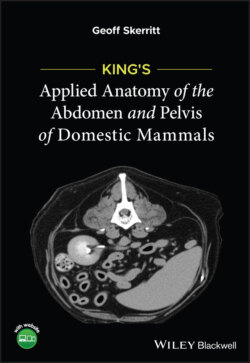Читать книгу King's Applied Anatomy of the Abdomen and Pelvis of Domestic Mammals - Geoff Skerritt - Страница 15
1 The Boundaries of the Abdomen 1.1 Introduction
ОглавлениеThe abdomen is the major cavity of the body in the domestic animals and human beings. It contains the gastrointestinal tract, the liver, spleen, pancreas, kidneys and the ovaries together with most of the female reproductive tract. The abdomen is separated from the thorax cranially by the diaphragm and the caudal ribs; caudally it is continuous with the pelvic cavity.
Dorsally the abdomen is bounded by the vertebrae. Laterally and ventrally the boundaries of the abdomen comprise the abdominal wall, a soft tissue structure consisting of muscle, connective tissue and the layers of the skin. The abdominal wall is capable of stretching in the short term, as when the gastrointestinal tract is full of ingesta, and more gradually to accommodate the expanding uterus in pregnancy.
Apart from the important functions of containing and protecting the abdominal contents, the muscular components of the abdominal wall can aid in the expulsion of faeces, urine and foetuses. In addition, contraction of the abdominal muscles can assist in breathing, coughing and sneezing.
